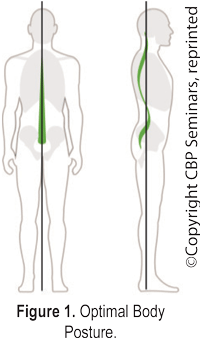INTRODUCTION
Posture has probably been one of the longest studied aspects of humans. The correlation of posture and health has driven us to study our posture since at least the time of Hippocrates.1 Since Hippocrates’ time, many have attempted to categorize man into constitutional posture types.1-3 Before any possible consequences of abnormal posture can be addressed, normal posture must be defined and precise measurement methods developed.
 DISCUSSION
DISCUSSION
• Ideal Upright Postural Alignment:
Ideal Posture is really a matter of simple engineering. The human body is designed such that the centers of mass of the head, ribcage, and pelvis should be perfectly centered and balanced on each other. From the front, the spine is perfectly aligned with gravity. But the spine, when viewed from the side, contains three curves to properly balance the weight of the body and allow free movement. Figure 1 depicts the proposed Ideal Posture Alignment. Note, ideal spinal curvatures that give rise to optimal postural alignment will be ignored for the purpose of this short presentation.
• Abnormal Postures as Rotations and Translations:
In 1974, Panjabi, White, and Brand4 presented a right-handed central orthogonal (Cartesian) coordinate system where local systems (i.e., body joints or segments) may be used to define human body joint and segment static positions or relative motions from the central system. My father (Dr. Donald Harrison) originally (in 1982) implemented this system to define human body posture as rotations and translations of the head, thoracic cage, and pelvis as 12 simple movements in 6 degrees of freedom.5-7
The single posture component rotations and translations of the head, thorax, and pelvis are shown in Figures 2 and 3. While there are only 36 possible single unique movements of the head, thorax, and pelvis shown in Figures 2 and 3,
complexity of this system of description is inherent. There can be singles, doubles, triples, quadruples, quintuples, and sextuples of rotations and translations for the head, thoracic cage, or pelvis.
For example, using just the head, there are 729 unique postural displacement combinations for the head relative to the ribcage; 728 of these would be abnormal postural displacements and one would be the ideal alignment position shown in Figure 1.
 • Measurement of Ideal and Abnormal Posture Alignment:
• Measurement of Ideal and Abnormal Posture Alignment:
Recently, CBP researchers developed a new computerized system (PosturePrint®), to measure head, rib cage, and pelvic postures as rotations and translations in three-dimensions in upright stance. In three separate validity studies,8-10 the PosturePrint system was found to be sufficiently accurate in measuring head, thoracic cage, and pelvic postures in five degrees of freedom: errors ≤ 3mm and 3°. Further, reliability of the PosturePrint measurements were found to have good to excellent examiner reliability.11
The use of the PosturePrint system allows detailed postural measurements to be used clinically to gauge an individual’s response to intervention and/or for research purposes.
Figure 4 depicts the front postural alignment using the PosturePrint system and the consequent displacements measured: left pelvic translation, left thoracic translation, left thoracic bending, and right head translation are the significant findings. A right lateral flexion of the skull is also present but does not reach the set threshold for clinical significance.

 • Postural Deformity, Pain, Disability & Health:
• Postural Deformity, Pain, Disability & Health:
The cause-effect relationship between postural deformity-abnormality and health disorders has been the subject of numerous investigations and review articles and it has advocates on both sides of the debate. A comprehensive review of this information is behind the scope of the current short presentation. However, recent high quality case control investigations have found interesting and significant differences between condition groups vs. control groups and significant correlations between abnormal posture alignment and a number of health disorders including:
• Abnormal thoraco-lumbar alignment and back and neck pain in children and adolescents;12,13
• Hyper-kyphosis-round back and health perceptions and function in adolescents;14,15
• Hyper-kyphosis and rigid anterior head translation and functional impairments in seniors;16
• Hyper-kyphosis and early mortality in seniors;17
• Abnormal cervical spine postures in women with chronic pelvic pain;18
• Abnormal forward head posture and neck pain, headaches, disability, range of motion, respiratory muscle function, and carpal tunnel syndrome.19-23
SUMMARY
This short paper has presented a fundamental yet rigorous model of ideal posture and consequent abnormal posture alignments as components of rotations and translations, as originated by Dr. Donald Harrison. The use of this posture model has many advantages. It is simple to implement into the clinical or research settings and easy to record and communicate between professionals.
Dr. Deed will be presenting a comprehensive, contemporary review of this topic at the upcoming 32nd CBP Annual Conference on Sept. 24-26th, in Scottsdale, AZ.
Deed E. Harrison, D.C. is President CBP Seminars, Inc., Vice President CBP® Non-Profit, Inc., Chair PCCRP Guidelines, Editor—AJCC.
References
Contact Dr. Deed for the detailed list of references accompanying this article: [email protected].
